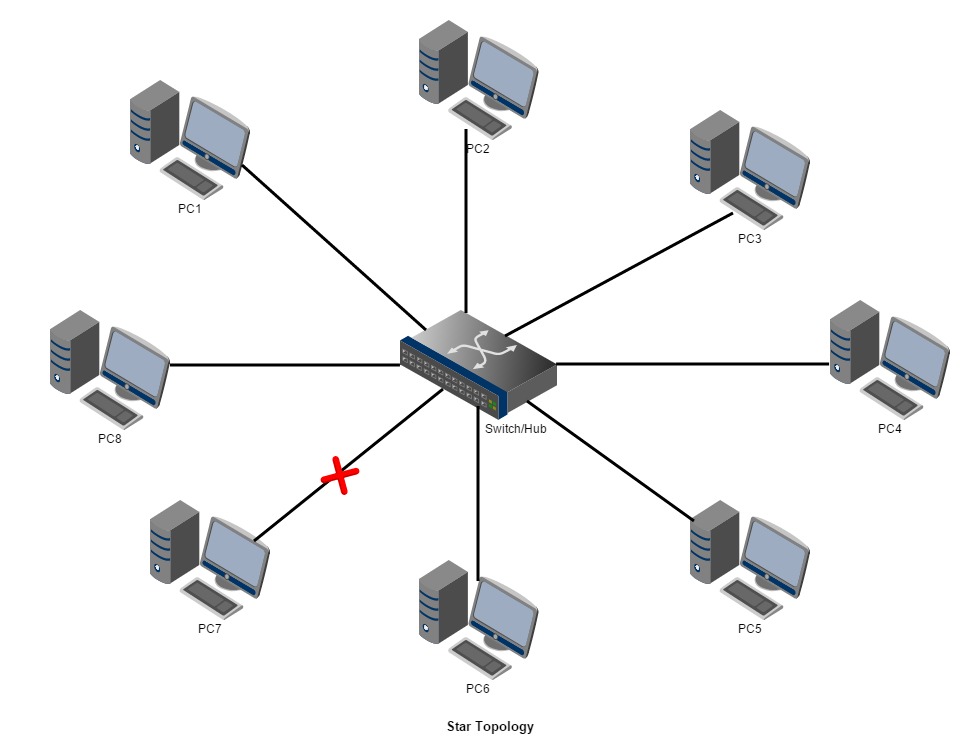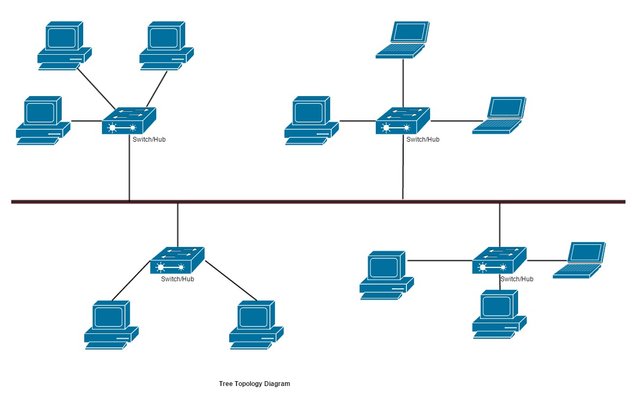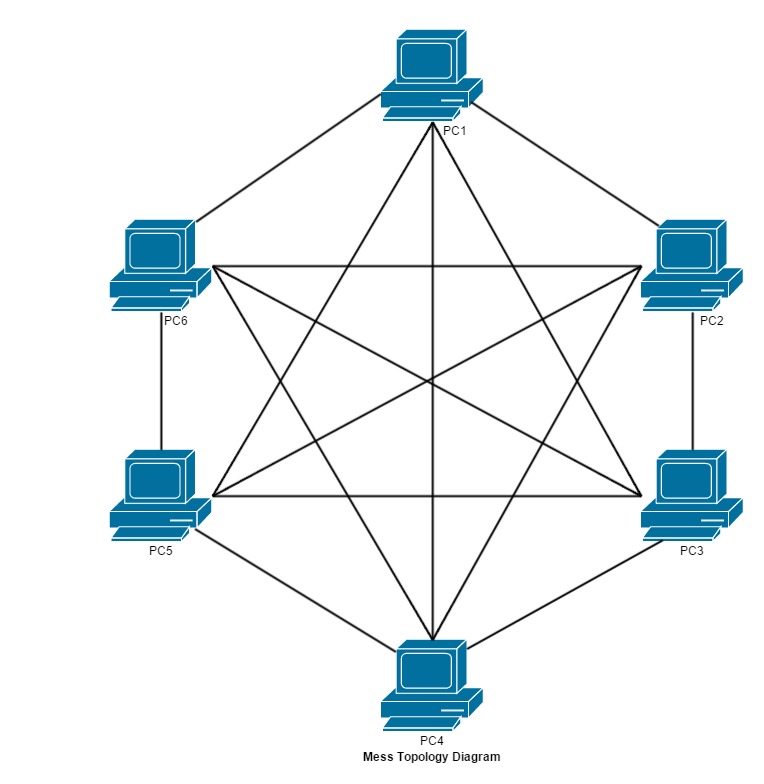What is Network Topology?
Network Topology refers to layout of a network and how different nodes in a network are connected to each other and how they communicate. Basically, it is the topological structure of a network and may be depicted physically or logically.There are six types of network topology
• Star Topology
• Bus Topology
• Ring Topology
• Mesh Topology
• Tree Topology
• Hybrid Topology
Star Topology :
In Star topology all computers/devices are connected to a central device called Hub/switch. All Computers/devices will be connected to Central Hub/Switch with a point to point connection.
All data in star topology passes through central hub/switch before it reach to destination device. Central device (Hub/switch) acts as a junction in the network and whole network control by the central device. Central device can also communicate with other hubs of different network. Unshielded Twisted Pair (UTP) Ethernet cable is used to connect workstations to central node .
Advantages :
• If one connection failed (PC7 in diagram) in the network then it doesn’t affect rest of the network. At the same time its easy to detect the failure and troubleshoot it.
• Easy to monitor whole network as the network is manage by central device
• In star topology new nodes can be added easily without affecting rest of the network. Similarly components can also be removed easily.
Disadvantages :
• Too many dependency on central device. If central device goes down then whole network will fall.
• Performance and as well number of nodes which can be added in such topology is depended on capacity of central device.jpg)
Bus Topology:
Bus Topology is the simplest of all typologies and also called as line topology. In Bus topology, all the nodes are connected to the single cable (called bus), by the help of interface connectors. This central cable is the backbone of the network and is known as Bus (thus the name). Every computers/devices communicates with the other device through this Bus.
A signal from the source is broadcast and it travels to all computers/devices connected to bus cable. Although the message is broadcast but only the intended recipient, whose MAC address or IP address matches, accepts it. If the MAC /IP address of machine doesn’t match with the intended address, machine discards the signal. A terminator is added at ends of the central cable, to prevent bouncing of signals. A barrel connector can be used to extend it.
Advantages:
• Its easy to setup computers/devices and extend network through bus topology
• Bus topology is less costly as cable length required for this topology is very less
• At certain point if one node lose connection lost then whole network willn’t go down. Chance of complete network goes down is very less
Disadvantages:
• Dependency on central cable in this topology has its disadvantages.If the main cable (i.e. bus ) encounters some problem, whole network breaks down.
• Data travel in the Bus both direction. So certain point data can collide which will lead to data loss. Proper termination is required to dump signals. Use of terminators is must.
• Efficiency of Bus network reduces, as the number of devices connected to it increases.
• Security is very low because all the computers receive the sent signal from the source.
• This is not a suitable solution for the network with heavy traffic
Ring Topology:
A Ring Topology is computer network where all computers/devices are connected each other in circular shape. Data packet travel around the network until it reach to the destination. Each workstation is connected to two other components on either side, and it communicates with these two adjacent neighbors. Data travels around the network, in one direction. Sending and receiving of data takes place by the help of TOKEN. This network is usually found in offices, schools and small buildings.
Token Passing:
Source system send token which contain piece of information along with the data. Token pass to next node from the souce system . Next node will check the token if it intended to the particular node or not. If yes, it receives it and passes the empty to into the network, otherwise passes token along with the data to next node. This process continues until the signal reaches its intended destination.The nodes with token are the ones only allowed to send data. Other nodes have to wait for an empty token to reach them.
Advantages:
• Ring topology is very organized concept. Each node gets to send the data when it receives an empty token. This helps to reduces chances of collision. Also in ring topology all the traffic flows in only one direction at very high speed.
• Ring Topology doesn’t required central node to manage connectivity between computers
• Additional components do not affect the performance of network
• Each computer has equal access to resources.
• Even when the load on the network increases, its performed better than bus topology
Disadvantage:
• Each data packet has to travel throughout the network . So ring topology makes slower network.
• If one workstation or port goes down, the entire network gets affected.
• If there are any problems with the network, they can be difficult to identify the root cause.
• Any change in the computers/device (moving, adding or changing) can affect the network.
Mesh Topology:
Mesh Topology is computer network where each nodes (computers or devices) are interconnected each other. Every node send data to other nodes as well relays data from other nodes.This type of network topology is very expensive as there are many redundant connections between nodes. So this isn't mostly used in computers networks. There are two type of mesh topology -
Full Mesh Topology: In full mesh topology all nodes are connected each other. Main advantage of this network traffic can be redirected to other nodes if one of the nodes goes down though cost is very high of this network. Full mesh topology is used only for backbone networks.
Partial Mesh Topology: In partial mesh topology some of the nodes (computers/devices) are connected in similar fashion as in mesh topology while rests of the systems are only connected to 1 or 2 devices. This is far more practical as compared to full mesh topology. This one is less costly and also reduces redundancy.
Advantages:
• If one of the connection fail in the network , it will not impact whole network .
• Data can be transmitted from different devices simultaneously.
• Expansion and modification in topology can be done without disrupting other nodes.
Disadvantages :
• Overall cost of this network is way too high as compared to other network topologies.
• Redundancy is very high in this network topology due to many of the network connections.
• Its very difficult to setup and maintain this kind of network compared to other topologies
Tree Topology:
A Tree topology is combination of Bus and Star topology.Basically nodes of the bus topology are replaced by standalone star topology networks.Another away number of star networks are connected through bus.This main cable(bus) seems like a main stem of a tree, and other star networks as the branches. Thats why we called this type of network topology as tree topology.This results in both disadvantages of bus topology and advantages of star topology.Ethernet protocol is commonly used in this type of topology.
Advantages :
• It is scalable. Secondary nodes allow more devices to be connected to a central node.
• Easy to expand this type of network .
• Whole network divided into segments (star networks), which can be easily managed and maintained.
• Each segment is provided with dedicated point-to-point wiring to the central hub.
• If one segment damaged int this network then other segment willn’t get impact.
• Fault detection and correction is very easy in this type of network
Disadvantages:
• Tree topology is heavily depends on main cable (bus). So if main cable breaks then whole network is crippled.
• Maintenance of this networks become difficult when more nodes and segments are get added.
• Scalability of the network depends on the type of cable used.
Hybrid Topology:
Hybrid topology is a computer network where two or more topologies are interconnected together to form a resultant topology which has good points (as well as weaknesses) of all the constituent basic topologies rather than having characteristics of one specific topology. But remember if two similar topology interconnect each other then we can’t call that hybrid topology.
Advantages:
• Hybrid topology can be designed such a way that strength of the topology is maximized and weakness minimized.
• Fault detection and correction is very each in this type of network compare to other network.
• Easy to expand network without disturbing existing architecture/network.
• This type of network can be designed according to the requirements and by optimizing the available resources. Special care can be given to nodes where traffic is high as well as where chances of fault are high.
Disadvantages:
• Its very tough to design this type of network as hybrid networks depends on organization requirements.
• As hybrid architectures are usually larger in scale, they require a lot of cables, cooling systems, sophisticate network devices, etc.

Wow good information. Let's follow each other closely and share good information.
I have shared couple of ararticles .Please share your view
Sure. Will share more